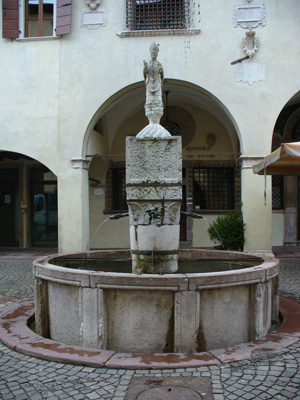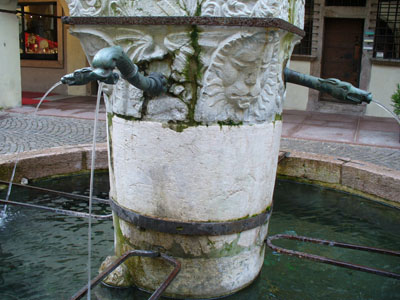| Card n. | Description | Locality | Linked sites |
| 59 | San Lucano Fountain | Belluno | 2 - 147 |
| file .pdf | Architecture Art History (ASA) |
Google maps | 146 - 1 |
 |
 |
- Description
- How to get there
- Interesting facts
- Bibliography
The fountain of San Lucano is considered the oldest and most characteristic monument in Piazza del Mercato – also known as Piazza delle Erbe - in Belluno. It is composed of a circular basin and a decorative column element in the centre, topped with a statue of San Lucano, the former Bishop of Bressanone. The words in the inscriptions, the decorative friezes and the five coats of arms sculpted on the square plinth of the statue and the column indicate that the fountain is the work of several different hands, commissioned by different people during different periods. It appears clear that the fountain was rebuilt in 1410 under the Podestà Benedetto Trevisan, over a previous one dating back to the preceding century, and that further structural work was carried out between 1461 and 1474 to add, in the lower part, the coats of arms of the Podestà Candiano Bolani and Antonio Basadonna. The inscription on the north side is believed by some to read MCCCIVII (1318), i.e. the end of the mandate of the Podestà Rambaldo da Romano, when a series of important work was carried out on the water pipes and fountains of the town. The fountain probably originally had a single sculpted side, the one facing north, decorated with the coat of arms of Belluno, and in 1409-10, when the Podestà Trevisan had work carried out on the fountain – perhaps as a result of damage to the water supply system caused by repeated earthquakes – he had the plinth turned 90 degrees anti-clockwise, thus affording the Lion of St. Mark the central position that until then had been occupied by the coat of arms of the town. From a letter written in 1826 by the master builder of the town regarding damage to the system, we know that “the dirty water from the Fontana del Mercato Vecchio […] continued to flow right to the basin outside the Porta del Macello gate […]”.
San Lucano, the bishop of Bressanone, is famous for having spread the Christian faith through the Valbelluna and Agordino areas in the 5th century, thus becoming one of the patron saints of the town and said to protect against slander, floods and a number of illnesses.
The Old Town of Belluno can be reached by going up the escalator from the Lambioi car park in the south of the town, near the river Piave.
The escalator comes straight out onto Piazza Duomo, surrounded by the offices of the main public institutions, and the main fountains of the town can be found in the lanes and little squares just off the Piazza.
ACCESSIBLE: yes
MUNICIPALITY: Belluno
PLACE: Piazza del Mercato
GEOGRAPHICAL COORDINATES: X 1748605 – Y 5114517
PROVINCE: Belluno
FILE COMPILED BY: Lonzi
The historian Piloni writes that “For the benefit of the people of the town, an aqueduct was built, where the source waters are collected in the house of Persicini in the quarter of Crosdecale, from where many underground channels and pipes set out to serve the public and private citizens”. What remains of the aqueduct can be seen in the large covered washtub in the courtyard of Palazzo Prosdocimi, behind the semi-circular La Motta fountain (147 HAA), built in the sixteenth-century, larger and more richly decorated than other fountains of a similar type in Belluno. The main fountains with a central column and a circular or polygon-shaped base, can be found in the most important public areas – in front of the Church of Santo Stefano, in Via Santa Maria dei Battuti, in Piazza Castello, in Borgo Piave and in Borgo Pra. The central column is generally connected to the base using square blocks or curved pieces placed on top of one another, or with fine sculpted ends, as is the case of the fifteenth-century fountain in Piazza Duomo (146 HAA), topped with a statue of San Gioatà. Just a few steps from the Cathedral is the Baptistery of Belluno (1 HAA), known by various names - Church of Santa Maria delle Grazie or San Martino or San Giovanni – as a result of the particular events it has played a role in over the centuries.
M. Perale, Le antiche fontane di Belluno: per una ridefinizione della successione cronologica degli interventi, taken from the “Archivio Storico Belluno Feltre Cadore”, LIXVIII, 298 January-March 1997, pp. 3-21
Catalogue of the Civic MuseumVol. III, B. Jestaz, Le placchette e i piccoli bronzi: T. Franco, Le sculture, Belluno, 1997
M. Dal Mas, R. M. Dal Mas, Le fontane di Belluno, Belluno, 1993
V. Caputo, 270 fontane per il Bellunese, Belluno, 1985
G. De Bortoli - A. Moro - F. Vizzutti, Belluno storia architettura arte, Belluno 1984

